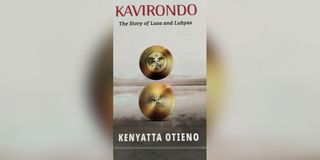
The cover page of the book Kavirondo: The Story of Luos and Luhyas by Kenyatta Otieno.
Not many Kenyans today know or remember the word Kavirondo and what it means. That is unless one is particularly interested in history, anthropology or culture.
Kavirondo refers to a part of western Kenya that is inhabited mostly by the people that are called Luo and Luhya. There are other ethnic groups in the region. However, because of their population sizes, the two communities dominate the region’s politics, economy and culture. The story of these people is told in a book by Kenyatta Otieno, “Kavirondo: The Story of Luos and Luhyas (2024)”.
This is not a book by a historian, anthropologist or cultural scholar. This is a popular history book. Anyone with an interest in the two communities and the social history of their people will find Kavirondo quite interesting.
Why? Because it offers the reader bits and pieces of information on the Luo and the Luhya: their origins; their cultures of the past and today; their relationship as neighbours; their politics etc.
This knowledge is gleaned from the author’s personal experiences (for instance, he speaks Isukha - a dialect of Luhya), books and archival material, stories and anecdotes told to him by friends and family etc. It is, therefore, not surprising that the book also contains anecdotal stereotypes such as ‘Luos are synonymous with political riots in Kenya’, ‘Luos are sentimental, typical of Purism’, or ‘when a Luo man has an affair, the world will know.’
But this is a book that adds immensely to the social history of Kenya. How do ordinary Kenyans live? What do they do that makes their everyday life manageable, productive, fulfilling or liveable?
Away from politics and struggles to make a livelihood, how do the Luo or the Luhya live with their neighbours? The big premise of Kavirondo is that the Luo and Luhya have lived as neighbours for so long such that in some of the villages in western Kenya, it is impossible to differentiate between them. It is not a difficult assumption to prove. One just needs to visit a village in Yala, Siaya County or Musanda, in Kakamega County or Matayos in Busia County. In these places, people easily switch from one language to the other. Most people who stay around Yala, Musanda or Matayos know both languages, out of necessity.
Why does someone need to know Luo or Luhya (the local version of it) in these places? Because either language will be used in church, at school, at the market, at a political rally or in a bar, for instance. Switching from one to the other establishes and marks one’s identity. It is a way of saying, “I am daughter or son of this village and community.” Speaking both tongues institutes trust. The speaker is likely to negotiate himself or herself out of a tricky situation or a favourable deal, say when buying some item.
Knowing and being able to speak the two tongues is not accidental. Intermarriages between the Luo of Gem and Banyore of Luanda (Vihiga County) produce children who visit and stay with relatives on either side of the ethnic divide during school holiday seasons, for instance. These children will learn their mother’s and father’s tongues in order to manage life in either home/village.
These children end up multilingual, speaking at least four languages, after picking Kiswahili and English (and French) at school. This is a feature of many parts of western Kenya, which has guaranteed harmonious co-existence between the two communities for centuries.
Cohesive community
The other value of Kavirondo is in the book reminding Kenyans that since the 1960s, the country has struggled to create a cohesive community. Benedict Anderson popularised the term ‘imagined communities.’ What kind of nation-state has Kenya sought to construct? Considering that the British dumped tens of ethnic communities into one mapped area and called it Kenya has always been offered as a reason for inter-ethnic rivalries and tension.
But were the Maasai always enemies of the Kikuyu? Evidence suggests that there was intermarriage and trade between the two communities. Indeed, the Kikuyu had one of its subgroups composed of people who traced their ancestry to the Maasai. What about the Luo and Kisii? Yes, they had fought at some time in the past but they traded, intermarried and lived next to each other.
The Luo-Luhya relationship is no different. In other words, the different ethnic communities in pre-colonial Kenya, like elsewhere in the world, had tensions and conflicts, some leading to war, destruction of property and deaths, but also had established mechanisms of resolving those tensions and guaranteeing co-existence.
So, why did the colonial system attempt to assign these communities what seemed like fixed boundaries, separating one community from the other? Consider that there has been an ongoing, seemingly irresolvable conflict between the Luhya and Luo over the boundaries of Maseno town - is it in Kisumu or Vihiga County? Or the never-ending tension between the Tigania and Tharaka over a boundary separating the two communities, who are members of the larger Meru community. Yet, these people had co-existed, skirmishing over, say pasture or water for their animals, but fixing such local issues through elders and rituals.
Why did the post-colonial government not imagine how to exploit the cultural mix that already existed between the different communities, and which had been enhanced by education, trade, migration, urbanisation, the presence of government offices and officers all over the country etc to create an inclusive nation-state? Why would the post-independence government deliberately marginalise what it deemed ‘unproductive’ areas?
Why has the idea that some regions deserve more government services and opportunities than others persisted for so long when those areas have benefited more from government economic policies since the pre-independence era? Why did the government ban ethnic associations in 1980 when tribe is a primary marker of identity for millions of Kenyans?
Why would anyone insist on ‘de-tribalising’ an individual who was born in a particular community, spoke one language, schooled in her village of birth, got married to a village-mate, gave birth to and raised children in that community, and only later migrated to a new place, with people and a culture different from hers?
The readers will indirectly be left with such questions after reading Kavirondo. How have the Luo and Luhya co-existed and see one another as shemeji in a country where politics has always divided citizens? Even the mashemeji derby, pitting Gor Mahia against AFC Leopards (funny that Abaluhya Football Club was deemed non-tribal by the government) is really about bragging rights till the next match rather than an inter-tribal contest. Why? Because many urban young supporters of these teams can hardly speak Luo or Luhya. But even for those who are Luo or Luhya damu, as they say on the streets, the support could be driven more by sports betting than the wish to see one’s tribe triumph over the other.
Kavirondo is not ‘the story of the Luos and Luhyas’ as the title suggests. It really is a collection of tales about and of these two communities, which are made up of different subgroups. It is not possible to create or imagine ‘the story’ of the Luo or the Luhya — they are just too many groupings of them, each one of the groupings having been formed from interaction with other non-Luo or non-Luhya groups. Knowing these tales about and of Kenya’s different communities — including the stereotypes — is the first step in appreciating the worth of every Kenyan, whatever tribe or race or nation they claim to belong to.
The writer teaches literature, performing arts and media at the University of Nairobi. [email protected]






